| Jewish Legion | |
|---|---|
 Jewish Legion soldiers in 1919 | |
| Active | 1917–1921 |
| Country | |
| Allegiance | |
| Branch | |
| Size | 5 battalions |
| Engagements | |
The Jewish Legion was an unofficial name used to refer to five battalions of the British Army's Royal Fusiliers regiment, which consisted of Jewish volunteers recruited during World War I. In 1915, the British Army raised the Zion Mule Corps, a transportation unit of Jewish volunteers, for service in the Gallipoli campaign. Two years later in August 1917, the decision was made to raise an infantry battalion of Jewish soldiers which would be integrated into an existing British Army regiment.
Eventually, due to large recruitment numbers, including Jews from Russia and the United States, five battalions were raised and integrated into the Royal Fusiliers; collectively, they were referred to as the "Jewish Legion". The new units raised were designated as the 38th, 39th, 40th, 41st and 42nd battalions of the regiment. The Jewish Legion saw action during the Sinai and Palestine campaign, where they fought at the Battle of Megiddo before being reduced to one battalion, nicknamed the "First Judaeans".
Background


In November 1914, David Ben-Gurion and Yitzhak Ben-Zvi proposed to the Ottoman commander in Jerusalem that a Jewish Legion could be raised to fight with the Ottoman Army.[1] The proposal was approved and training began but was soon cancelled by Djemal Pasha, who became known for persecuting Zionists.[1] Ben-Gurion and Ben-Zvi were among thousands of Jews deported.[1]
In February 1915, a small committee in Alexandria approved a plan of Zeev Jabotinsky and Joseph Trumpeldor to form a military unit from Russian Jewish émigrés from Palestine that would participate in the British effort to seize Palestine from the Ottoman Empire.[2] The British commander General Maxwell met a delegation, led by Jabotinsky, on 15 March. The General said he was unable, under the Army Act, to enlist foreign nationals as fighting troops, but that he could form them into a volunteer transport Mule Corps.[2][3] Jabotinsky rejected the idea and left for Europe to seek other support for a Jewish unit, but Trumpeldor accepted it and began recruiting volunteers from among the local Jews in Egypt and those who had been deported there by the Ottomans in the previous year.[2] The British Army formed 650 of them into the Zion Mule Corps, of which 562 served in the Gallipoli Campaign.[2]
Gallipoli Front


The need on the Gallipoli peninsula for means to carry water to the troops was considered so urgent that in mid-April, a request was forwarded to Egypt for the Zion Mule Corps to be sent immediately, regardless of its lack of equipment.[4] Its commanding officer was Lieutenant-Colonel John Henry Patterson, DSO, an Irish Protestant, and Captain Trumpeldor was Second-in-command. The Zion Mule Corps landed at Cape Helles from 27–28 April, four weeks after being raised, having been stranded at Mudros when its ship ran aground. The corps was embarked in the same ship as the Indian 9th Mule Corps bound for Gaba Tepe and so a detour to Helles was ordered. The Zion Mule Corps was disembarked under artillery fire from the Asiatic shore, with help of volunteers from the 9th Mule Corps and began carrying supplies forward immediately.[5]
A Distinguished Conduct Medal was awarded to Private M. Groushkowsky, who, near Krithia on 5 May, prevented his mules from stampeding under heavy bombardment and despite being wounded in both arms, delivered the ammunition.[6] Trumpeldor was shot through the shoulder but refused to leave the battlefield.[7] Patterson later wrote: "Many of the Zionists whom I thought somewhat lacking in courage showed themselves fearless to a degree when under heavy fire, while Captain Trumpeldor actually revelled in it, and the hotter it became the more he liked it ..."
The men returned to Alexandria on 10 January 1916. The Zion Mule Corps were disbanded on 26 May 1916. The Commonwealth War Graves Commission lists 13 members of the Zion Mule Corps as fatalities.[8]
Formation
Between the dissolution of the Zion Mule Corps and the formation of the Jewish Legion, Jabotinsky and Trumpeldor and 120 Zion Mule Corps veterans served together in 16 Platoon of the 20th Battalion, London Regiment.
In August 1917, the formation of a Jewish battalion was officially announced. The unit was designated as the 38th Battalion of the Royal Fusiliers and included British volunteers, as well as members of the former Zion Mule Corps and a large number of Russian Jews. In April 1918, it was joined by the 39th Battalion, raised at Fort Edward, Nova Scotia, which was made up almost entirely of Jews who were resident in the United States and Canada.[9]
Thousands of Palestinian Jews also applied to join the Legion and in 1918, more than 1,000 were enlisted. Ninety-two Ottoman Jews who had been captured in the fighting earlier were also permitted to enlist. This group was organized as the 40th Battalion. The 41st and 42nd Battalions were depot battalions stationed in Plymouth, England. In his memoirs about the Legion Jabotinsky described the composition of the 5,000-member Legion as; "thirty-four per cent from the United States, thirty per cent from Palestine, twenty-eight per cent from England, six per cent from Canada, one per cent Ottoman war prisoners, one per cent from Argentina." The soldiers of the 38th, 39th and later the 40th Battalions of the Royal Fusiliers served in the Jordan Valley and fought the Ottomans north of Jerusalem.
Action in the Jordan Valley, 1918
In June 1918, the volunteers of the 38th Battalion began engaging the Ottomans some twenty miles north of Jerusalem. In the fighting in the Jordan Valley, more than twenty Legionnaires were killed, wounded, or captured, the rest came down with malaria, and thirty of this group later died. The 38th Battalion served in the 31st Brigade of the 10th (Irish) Division. The Legion then came under the command of Major-General Edward Chaytor,[10] who commanded the ANZAC Mounted Division.
Besides various skirmishes, the Legion also participated in the Battle of Megiddo in mid-September 1918, widely considered to have been one of the final and decisive victories of the Ottoman front.
The Legion's mission was to cross the Jordan River. Jabotinsky led the effort. Later, he was decorated and Chaytor told the Jewish troops: "By forcing the Jordan fords, you helped in no small measure to win the great victory gained at Damascus."
In August 1919 fifty-six men from the Battalion were court-martialled for refusing to continue guarding prisoners of war in the Egyptian desert. They received sentences of 2 to 7 years hard labour.[11]
Legacy
| Battalion | Fatalities |
|---|---|
| 38th | 43 |
| 39th | 23 |
| 40th | 12 |
| 42nd | 3 |
| 38th/40th | 9 |
| Transferred from Jewish Legion | 1 |
Almost all the members of the Jewish regiments were discharged immediately after the end of the First World War in November 1918. Some of them returned to their respective countries, others settled in Palestine to realize their Zionist aspirations – among them the future first Prime Minister of Israel, David Ben-Gurion. In late 1919, the Jewish Legion was reduced to one battalion titled First Judaeans, and awarded a distinctive cap badge, a menorah with the Hebrew word קדימה Kadima (forward) at the base.
Former members of the Legion took part in the defence of Jewish communities during the Riots in Palestine of 1920, which resulted in Jabotinsky's arrest. Two former members of the Legion were killed with Trumpeldor at Tel Hai. One former member of the Legion was killed in Tel Aviv-Yafo during the Jaffa riots of 1921. Some members of the Jewish Legion settled in moshav Avihayil and moshav Be'er Tuvia. Another former member died in service in the Second World War.
Gallery
_%D7%9E%D7%A1%D7%93%D7%A8_%D7%91%D7%9E%D7%A6%D7%A8%D7%99%D7%9D.-PHG-1003805.png.webp) Zion Mule Corps Ammunition Company in Egypt 1915
Zion Mule Corps Ammunition Company in Egypt 1915 A recruitment poster showing Daughter of Zion: "Your Old New Land must have you! Join the Jewish regiment."
A recruitment poster showing Daughter of Zion: "Your Old New Land must have you! Join the Jewish regiment." Colonel John Henry Patterson.
Colonel John Henry Patterson. Colonel Eliezer Margolin of the "First Judeans".
Colonel Eliezer Margolin of the "First Judeans".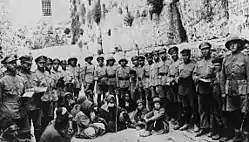 December 1917. Jewish Legion soldiers at the Western Wall after the British take-over of Jerusalem.
December 1917. Jewish Legion soldiers at the Western Wall after the British take-over of Jerusalem.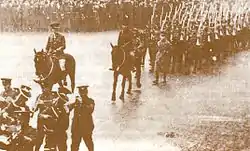 February 1918 The 38th battalion of the Jewish Legion marches in the streets of London.
February 1918 The 38th battalion of the Jewish Legion marches in the streets of London. Lt. Ze'ev Jabotinsky MBE in uniform of 38th RF (centre seated).
Lt. Ze'ev Jabotinsky MBE in uniform of 38th RF (centre seated).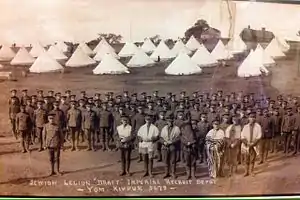 39th Battalion, Jewish Legion, at Fort Edward (Nova Scotia), Yom Kippur, 1918.
39th Battalion, Jewish Legion, at Fort Edward (Nova Scotia), Yom Kippur, 1918.%252C_Helmieh_Camp%252C_Cairo%252C_August_1918.jpg.webp) Officers of 39th Royal Fusiliers (Jewish), Helmieh Camp, Cairo, August 1918.
Officers of 39th Royal Fusiliers (Jewish), Helmieh Camp, Cairo, August 1918. Col. Margolin leading the 39th Battalion of the Jewish Legion through Bet Shemen.
Col. Margolin leading the 39th Battalion of the Jewish Legion through Bet Shemen. Jewish Legion camped at what would become Shilo, Mateh Binyamin
Jewish Legion camped at what would become Shilo, Mateh Binyamin Gershon Agron in his Jewish Legionnaire uniform, 1918
Gershon Agron in his Jewish Legionnaire uniform, 1918 Private Yitzhak Ben-Zvi, a volunteer in the Jewish Legion 1918.
Private Yitzhak Ben-Zvi, a volunteer in the Jewish Legion 1918. Private David Ben-Gurion, a volunteer in the Jewish Legion 1918.
Private David Ben-Gurion, a volunteer in the Jewish Legion 1918. Yaakov Dori
Yaakov Dori.jpg.webp) Private Jacob Epstein
Private Jacob Epstein Shimon Kushner in the uniform of the Hebrew Battalion 1918
Shimon Kushner in the uniform of the Hebrew Battalion 1918 HaYishuv Volunteers for British Army 1918.
HaYishuv Volunteers for British Army 1918. Jewish Legion Soldiers at El Arish Egypt 1918
Jewish Legion Soldiers at El Arish Egypt 1918 The Jewish Legion celebrates Passover 1919.
The Jewish Legion celebrates Passover 1919. The choir of the Jewish Legion.
The choir of the Jewish Legion. Jewish Legion Standard 1 January 1915 it reads "By Blood and Fire Judea fell-By Blood and Fire Judea will rise"
Jewish Legion Standard 1 January 1915 it reads "By Blood and Fire Judea fell-By Blood and Fire Judea will rise" Jewish Legion standard 1 January 1918
Jewish Legion standard 1 January 1918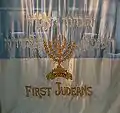 The flag of the First Judeans 1919–1921.
The flag of the First Judeans 1919–1921. The cap badge of the First Judaeans 1919–1921: menorah and word קדימה Kadima
The cap badge of the First Judaeans 1919–1921: menorah and word קדימה Kadima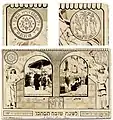 Judea Liberated postcard. At the lower right is a Jewish Legion soldier.
Judea Liberated postcard. At the lower right is a Jewish Legion soldier. Jewish Legion Veterans March in Jerusalem in protest against the "Palestine White Paper" restricting Jewish Immigration 18 May 1939
Jewish Legion Veterans March in Jerusalem in protest against the "Palestine White Paper" restricting Jewish Immigration 18 May 1939 1940 Poster featuring Jabotinsky of the Jewish Legion. For contributions to Keren Hayesod.
1940 Poster featuring Jabotinsky of the Jewish Legion. For contributions to Keren Hayesod. Veterans of the Jewish Legion, 27 September 1942, Tel Aviv.
Veterans of the Jewish Legion, 27 September 1942, Tel Aviv. Private Morris Ziggles of the 39th Battalion and his daughter Stella, 1917.
Private Morris Ziggles of the 39th Battalion and his daughter Stella, 1917.
Notable members
- John Henry Patterson, Commander of Zion Mule Corps and 38th Battalion Royal Fusiliers
- Gershon Agron, Mayor of Jerusalem
- Nathan Ausubel, Jewish-American author
- Yitzhak Ben-Zvi, second Israeli President
- Yaakov Dori, Haganah leader; first Chief of Staff of the Israel Defense Forces, President of the Technion – Israel Institute of Technology
- Maxwell H. Dubin, rabbi, Wilshire Boulevard Temple, Los Angeles
- Sir Jacob Epstein, British sculptor
- Levi Eshkol, third Prime Minister of Israel
- Louis Fischer, Jewish-American journalist and author
- Eliyahu Golomb, founding member of the Haganah
- David Grün, later Ben-Gurion, first Israeli Prime Minister
- Nachum Gutman, Israeli painter
- Dov Hoz, Zionist activist, Haganah fighter
- Julius Jacobs, brother-in-law of Moshe Smilansky; killed in the King David Hotel bombing, 22 July 1946
- Bernard Joseph, later Dov Yosef, Governor of Jewish Jerusalem during the 1948 siege; longtime Labor MK
- Berl Katznelson, Zionist philosopher and activist
- Reuven Katzenelson, Sergeant under Joseph Trumpeldor at Battle of Gallipoli and father of Shmuel Tamir
- Bert "Yank" Levy, Internationalist in Spain and military instructor for the British Home Guard. His work served as the basis for a popular handbook on guerrilla warfare.[13]
- Gideon Mer,[14] physician, veteran of Zion Mule Corps, Jewish Legion and British Army in the Second World War. Served as a medic in the 1947–1949 Palestine war; later worked in the Israeli Ministry of Health. (Note: he is the unnamed officer in charge of an anti-malaria programme during the Second World War – mentioned in Martin Sugarman's article[15] on the Zion Mule Corps.)
- Nehemiah Rubitzov, father of Yitzhak Rabin
- Israel Rosenberg, also known as 'The grandfather of the Jewish Legion'[16]
- James Armand de Rothschild, DCM Major, 39th Royal Fusiliers Battalion; Captain Royal Canadian Dragoons; a member of the Rothschild family
- Redcliffe N. Salaman, medical officer, from April 1918 in Egypt and Palestine, 38th Battalion, then 39th of Royal Fusiliers
- Edwin Herbert Samuel, 2nd Viscount Samuel; CMG son of Herbert Samuel, 1st Viscount Samuel
- Moshe Smilansky, pioneer of the First Aliyah, a Zionist leader who advocated peaceful coexistence with the Arabs in Mandatory Palestine, a farmer, and a prolific author
- Edward Sperling, humourist and later director-general of the Ministry of Trade and Industry under the British Mandate of Palestine; killed in the 1946 King David Hotel bombing
- Eleazar Sukenik, Israeli archaeologist; father of Yigael Yadin
- David Tidhar, Police officer, private investigator and author
See also
- Jewish Brigade, a similar military formation of volunteer Jews in the British Army that fought in the Second World War
- Jewish Legion (Anders Army), a proposed unit in the Polish Anders Army in USSR during the Second World War
- Tilhas Tizig Gesheften, organisation which grew out of the Jewish Brigade
References
- 1 2 3 Joseph B. Schechtman (2007). "Jewish Legion". Encyclopaedia Judaica. Vol. 11 (2 ed.). Macmillan Reference USA. p. 303.
- 1 2 3 4 Joseph B. Schechtman (1956). Rebel and Statesman, The Vladimir Jabotinsky Story, The Early Years. New York: Thomas Yoseloff. pp. 203–207.
- ↑ "The Zion Muleteers of Gallipoli – Jewish Virtual Library". Retrieved 21 February 2015.
- ↑ Aspinall-Oglander 1929, p. 122.
- ↑ Alexander 1917, pp. 146–148, 154.
- ↑ "Page 1062 – Issue 12828, 9 July 1915 – Edinburgh Gazette – The Gazette". Retrieved 21 February 2015.
- ↑ Patterson 1916, pp. 210, 123–124, 204.
- ↑ Reading Room Manchester. "CWGC – Find War Dead". Retrieved 21 February 2015.
- ↑ EMAIL, Jewish Magazine. "the Jewish Legion and the Israeli Army". Retrieved 21 February 2015.
- ↑ Bio of E.W.C. Chaytor (firstworldwar.com)
- ↑ Teveth, Shabtai (1987) Ben-Gurion. The Burning Ground. 1886-1948. Houghton Mifflin. ISBN 978-0-395-35409-4. p.149
- ↑ Approximate numbers, according to Commonwealth War Graves Commission.
- ↑ Levy, Bert "Yank"; Wintringham, Tom (Foreword) (1964) [1942]. Guerilla Warfare (PDF). Paladin Press. Archived from the original (PDF) on 12 April 2014. Retrieved 15 April 2014.
- ↑ "Mer, Professor Gideon". Israel War Veterans League. Archived from the original on 25 December 2007. Retrieved 12 March 2008.
- ↑ The Zion Muleteers of Gallipoli (March 1915 – May 1916) article. Retrieved 11 November 2018
- ↑ "מכון ז'בוטינסקי | Item". en.jabotinsky.org.
Sources
- Aspinall-Oglander, C. F. (1929). Military Operations Gallipoli: Inception of the Campaign to May 1915. History of the Great War Based on Official Documents by Direction of the Historical Section of the Committee of Imperial Defence. Vol. I (1st ed.). London: Heinemann. OCLC 464479053.
- Alexander, H. M. (1917). On Two Fronts: Being the Adventures of an Indian Mule Corps in France and Gallipoli. London: Heinemann. OCLC 12034903.
- Patterson, J. H. (1916). With the Zionists in Gallipoli. London: Hutchinson. OCLC 466253048.
Further reading
- Patterson, John H. With the Judaeans in the Palestine campaign. Uckfield : Naval & Military Press, [2004 reprint] ISBN 978-1-84342-829-9
- Jabotinsky, Vladimir. The story of the Jewish Legion. New York: Bernard Ackerman, 1945. OCLC 177504
- Freulich, Roman. Soldiers in Judea: Stories and vignettes of the Jewish Legion. Herzl Press, 1965. OCLC 3382262
- Gilner, Elias. Fighting dreamers; a history of the Jewish Legion in World War One,: With a glimpse at other Jewish fighting groups of the period. 1968. OCLC 431968
- Gilner, Elias. War and Hope. A History of the Jewish Legion. New York; Herzl Press: 1969. OCLC 59592
- Keren, Michael and Shlomit Keren, We Are Coming, Unafraid: The Jewish Legions and the Promised Land in the First World War. Lanham MD: Rowman & Littlefield, 2010. ISBN 978-1-4422-0550-5 OCLC 700447107
- Kraines, Oscar. The soldiers of Zion: The Jewish Legion, 1915–1921. 1985. OCLC 13115081
- Lammfromm, Arnon, Izhak Ben-Zvi and the Commemoration of Joseph Binyamini: A Failed Attempt to Create a Site of National Heritage", Archion, 17, Winter 2013, pages 48–55, 68 (Hebrew and English abstract)
- Marrion, R.J. "The Jewish Legion," 39th (service) Battalion, Royal Fusiliers (City of London Regiment), 1918–1919. 1987.
- Watts, Martin. The Jewish Legion and the First World War. 2004. ISBN 978-1-4039-3921-0
- "When the spirit of Judah Maccabee hovered over Whitechapel Road and – The march of the 38th Royal Fusiliers" by Martin Sugarman, Western Front Association Journal, Jan 2010.
External links
- The Zion Muleteers of Gallipoli (March 1915 – May 1916) by Martin Sugarman (Jewish Virtual Library). Retrieved 21 June 2006.
- Jewish Legion and Jewish East End of London Link
- CWGC record of I Bendow
- Note Born Israel Bendow Feigelman
